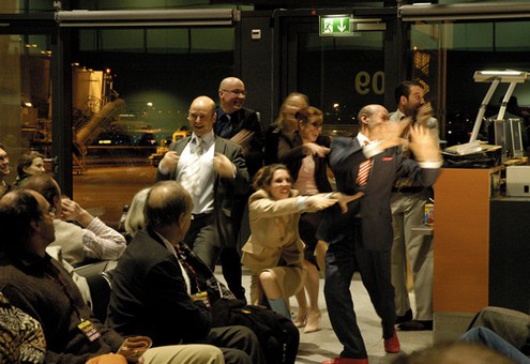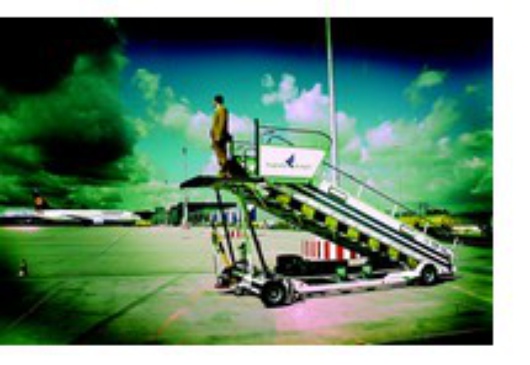Stuttgart's Lokstoff: taking theatre to the city
Published on
Translation by:
 Lucy Davies
Lucy Davies
No curtains, no stage. No cushioned rows of seats, no peep-show principle. The Stuttgart theatre group perform outside in urban spaces, right where the action is - be it in an airport, train station, underground station or buses driving their daily routes
A service bus, central Stuttgart. A completely normal bus stop. A man steps on. No free seats – he stands in the middle, holds on and looks confused. Why are they all chanting? Something is not quite right here. Next stop - The bus passengers are still chanting. Obviously unsettled, the man takes flight and leaves the bus.
 What was that? A ‘mischance’? The bus is not in service; it's a theatre bus with an audience and actors instead of real passengers. The passenger who inadvertently got on at the bus stop is an involuntary actor in Vorher/ Nachher )'Backwards/ Forwards'), based on Franz Kafka’s The Metamorphosis (1916).
What was that? A ‘mischance’? The bus is not in service; it's a theatre bus with an audience and actors instead of real passengers. The passenger who inadvertently got on at the bus stop is an involuntary actor in Vorher/ Nachher )'Backwards/ Forwards'), based on Franz Kafka’s The Metamorphosis (1916).
(Photo: ©Lokstoff)
Formed in 2002 by three actors, Kathrin Hildebrand, Wilhelm Schneck and Andrea Leonetti, Lokstoff have earned themselves an outstanding reputation within Stuttgart’s cultural scene. 'Even young people or people who are not classical theatre goers watch our performances. That, of course, makes us really happy,' says Lokstoff's manager Tom Schößler.
Lokstoff turn the rules upside down by organising a venue before searching for a play. The only requirement is that everyone must be able to access the location. 'The ideal performance venue must by all accounts play a public role,' says Schößler. There must be passersby – for example in the Charlottenplatz underground station in Stuttgart. It's a hub of the city 'with scruffy, dirty corners,' explains Schößler. 'Lots of people pass by everyday. We want to sensitise people to their surroundings through our theatre. We want to get something out of the place that people don’t notice at first glance.'
Lokstoff trailer
Each performance is a new challenge in which not only the content of the play and the actors lead. The setting, audience and passersby can also take on their own roles. Lokstoff founder Hildebrand says that 'as an actress, what is special is that every evening’s performance is different and exciting due to its confrontation with reality.'
Theatre at the gate
 It is not only at bus stops that the actors ambush passersby, but at underground stations, the train station and the airport. Kathrin Hildebrand remembers an incident during a performance of Top Dogs at Stuttgart airport. 'We were playing in a waiting lounge behind security. I was a trainer in an outplacement agency who was preparing a redundant manager to get back into the job market,' she says. 'In one scene I confront a colleague about his redundancy to make him come to terms with his situation in the outplacement agency. My fellow actor had to react strongly to that, scream out loud and tear the clothes from his body.'
It is not only at bus stops that the actors ambush passersby, but at underground stations, the train station and the airport. Kathrin Hildebrand remembers an incident during a performance of Top Dogs at Stuttgart airport. 'We were playing in a waiting lounge behind security. I was a trainer in an outplacement agency who was preparing a redundant manager to get back into the job market,' she says. 'In one scene I confront a colleague about his redundancy to make him come to terms with his situation in the outplacement agency. My fellow actor had to react strongly to that, scream out loud and tear the clothes from his body.'
'Top Dogs' performance at Stuttgart airport (Photo: ©Lokstoff)
Suddenly a ‘real’ manager emerged amongst the audience, dripping with sweat  and rushing around. I had to tell him straightaway where the flight to London left from. I told him he should calm down, that he had definitely booked another seminar and sent him to the airport information desk. The ‘real’ manager had then angrily begun a conversation with me and after a little while ran away swearing. The performance carried on, but by this time the audience were no longer quite sure whether it was 'real' or if the man was an actor.'
and rushing around. I had to tell him straightaway where the flight to London left from. I told him he should calm down, that he had definitely booked another seminar and sent him to the airport information desk. The ‘real’ manager had then angrily begun a conversation with me and after a little while ran away swearing. The performance carried on, but by this time the audience were no longer quite sure whether it was 'real' or if the man was an actor.'
Hamlet at the train station
The next Lokstoff project is premiering soon. From April, the troupe will be playing Stuttgart central train station. The actors have sought out a Shakespeare classic for this new setting. Hamlet (amidst platforms, departures and arrivals boards and bustling crowds), will be a symbol for the modern individual in an ever more complex world.
Passersby watch the rehearsals at the station, but that does not worry the actors. 'On the contrary,' says Schößler. 'Up until now we have had only good experiences. People watch and then ask when the play is starting and where they can get tickets.' There the passers by are already part of the action, inside the Lokstoff theatre. After all that is part of the concept. According to Schößler, 'we are using our freedom to perfom there, taking the theatre to the city.'
Translated from Lokstoff: Spielen, wo das Leben ist


